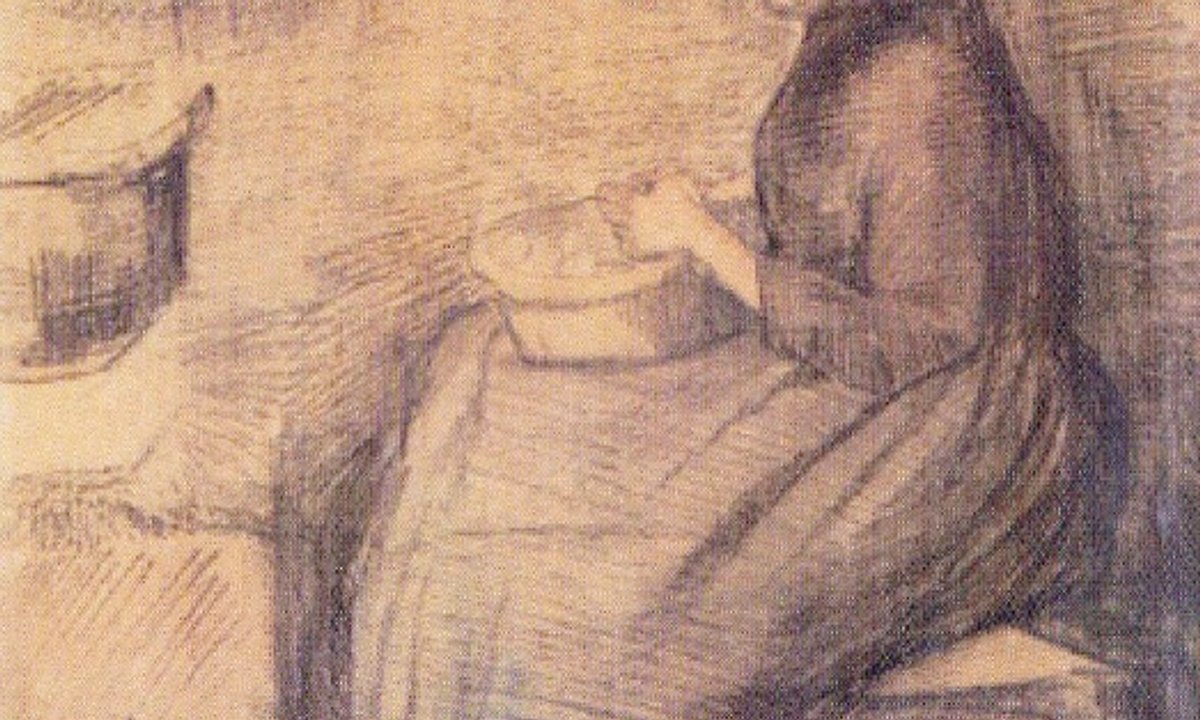Stolen, still missing: Van Gogh’sWoman sitting by the Fire, peeling Potatoes (May-June 1885)
Van Buuren Museum, Brussels
Adventures with Van Gogh is a weekly blog by Martin Bailey, our long-standing correspondent and expert on the artist. Published every Friday, his stories range from newsy items about this most intriguing artist to scholarly pieces based on his own meticulous investigations and discoveries. © Martin Bailey
The figures on Van Gogh thefts are chilling: 50 paintings, drawings and prints seized in 24 incidents since 1958. This is revealed in Lex Boon’s book De gestolen Van Goghs (The Stolen Van Goghs), which records how the artist’s work has been targeted.
Van Gogh’s The Bedroom (October 1888) and Sunflowers (January 1889)
Van Gogh Museum, Amsterdam (Vincent van Gogh Foundation)
By far the most serious theft took place in the early hours of 14 April 1991, when 20 paintings were seized by armed robbers at the Van Gogh Museum in Amsterdam. These included masterpieces such as the Sunflowers (January 1889) and The Bedroom (October 1888). The thieves abandoned their getaway car a few kilometres away and fled, with police recovering the works minutes later. Three paintings were scratched, but fortunately the remainder were not seriously damaged. The men were later convicted and security at the museum was upgraded.
Of the remaining thefts recorded by Boon, all involved single works, except for incidents involving two or three paintings on each occasion in 1965, 1988, 1990, 1998 and 2002.
Disturbingly, two paintings have been stolen twice. The watercolour Breton Women in the Meadow (after Emile Bernard) (December 1888) was seized from Milan’s Galleria d’Arte Moderna on 17 February 1975 and recovered on 6 April. Five weeks later, on 15 May, the Van Gogh was stolen again along with other works. It was then recovered on 1 November 1975.
Van Gogh’s Breton Women in the Meadow (after Emile Bernard) (December 1888)
Galleria d’Arte Moderna, Milan
The other painting which has been stolen twice is Vase with Flowers (summer 1886), from Cairo’s Mohamed Mahmoud Khalil Museum. It was taken in 1978 and recovered two years later. In 2010 it was stolen again, resulting in the closure of the museum for over a decade. The Cairo museum was reopened in 2021, but the still life has still not been recovered.
Van Gogh's Vase with Flowers (summer 1886)
Mohamed Mahmoud Khalil Museum, Cairo
Three other Van Goghs remain unrecovered, so any information on their possible whereabouts would be most welcome. Landscape in the neighbourhood of Saint-Rémy (October 1889) was stolen in 1980 from a private residence in Paris. A windblown Tree (August-September 1883) was also with a private collector when it was seized in Zurich in 1987. The drawing Woman sitting by the Fire, peeling Potatoes (May-June 1885) was taken from the Van Buuren Museum in Brussels in 2013.
Van Gogh’s Landscape in the neighbourhood of Saint-Rémy (October 1889), A windblown Tree (August-September 1883) and Woman sitting by the Fire, peeling Potatoes (May-June 1885)
Private collection, Paris; private collection, Zurich; Van Buuren Museum, Brussels
The good news is that Van Gogh works seem to be becoming increasingly secure. During the period 1958-99 there were 18 thefts, but since 2000 there have been only six. It is also encouraging that with 50 stolen paintings, all but four have been recovered.
Van Gogh’s The Parsonage Garden with Figures (November 1885)
The Parsonage Garden with Figures (November 1885) is recorded in the 1970 Van Gogh catalogue raisonné by Jacob Baart de la Faille as “destroyed in the Battle of Arnhem, 1944”, in the east of the Netherlands near the German border. Boon has investigated the case, uncovering evidence which suggests that the picture may well have survived.
The painting’s former owner, Adriaan Pieter van Hoey Smith (1893-1967), reported it as stolen soon after the war. In 1964 he wrote to the de la Faille committee, saying that his Van Gogh had “disappeared” during the Arnhem battle. But the committee mistakenly concluded that the picture had been “destroyed”.
Boon concludes: "The last known location of the painting was a house in Oosterbeek, whose villagers were evacuated during the Battle of Arnhem. I believe that the Van Gogh was probably looted by the Germans. It is therefore possible the painting survives and could one day turn up."
Martin Bailey is a leading Van Gogh specialist and special correspondent for The Art Newspaper. Bailey has curated Van Gogh exhibitions at the Barbican Art Gallery, Compton Verney/National Gallery of Scotland and Tate Britain.
Martin Bailey’s recent Van Gogh books
Bailey has written a number of bestselling books on Van Gogh’s years in France: The Sunflowers Are Mine: The Story of Van Gogh's Masterpiece (Frances Lincoln 2013 (UK and US), Studio of the South: Van Gogh in Provence (Frances Lincoln 2016 (UK and US), Starry Night: Van Gogh at the Asylum (White Lion Publishing 2018, UK and US) and Van Gogh’s Finale: Auvers and the Artist’s Rise to Fame (Frances Lincoln 2021, UK and US). The Sunflowers are Mine (UK and US) and Van Gogh’s Finale (UK and US) are also now available in a more compact paperback format. Living with Vincent van Gogh: the Homes and Landscapes that shaped the Artist (White Lion Publishing 2019, UK and US) provides an overview of the artist’s life. The Illustrated Provence Letters of Van Gogh has been reissued (Batsford 2021, UK and US). My Friend Van Gogh/Emile Bernard provides the first English translation of Bernard’s writings on Van Gogh (David Zwirner Books 2023, UK and US).
To contact Martin Bailey, please email [email protected]. Please note that he does not undertake authentications.
Read more from Martin's Adventures with Van Gogh blog here.
Their astonishing 1896 exhibition is now being celebrated by the Groninger Museum in the Netherlands
Other highlights include the dramatic recovery of a stolen painting and an astonishing donation
A revelatory exhibition in Amsterdam on Vincent’s landscapes from the outskirts of Paris—along with those of his avant-garde colleagues

